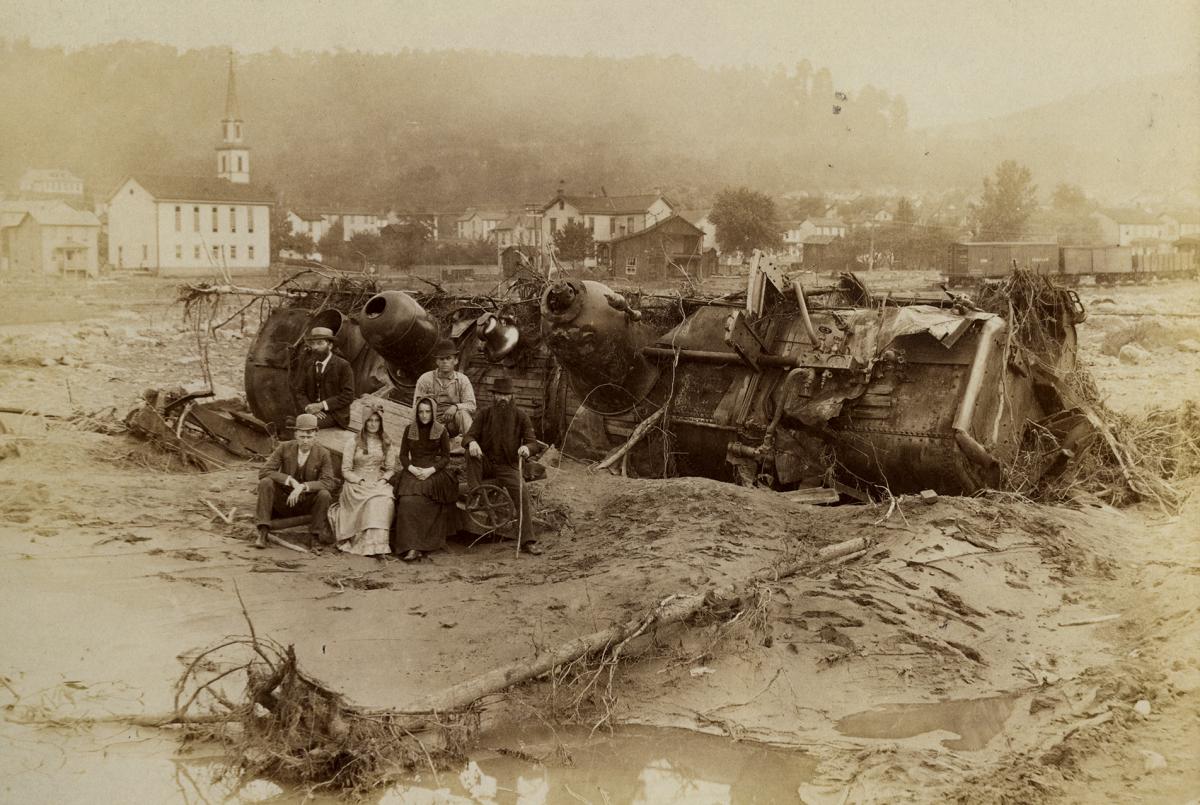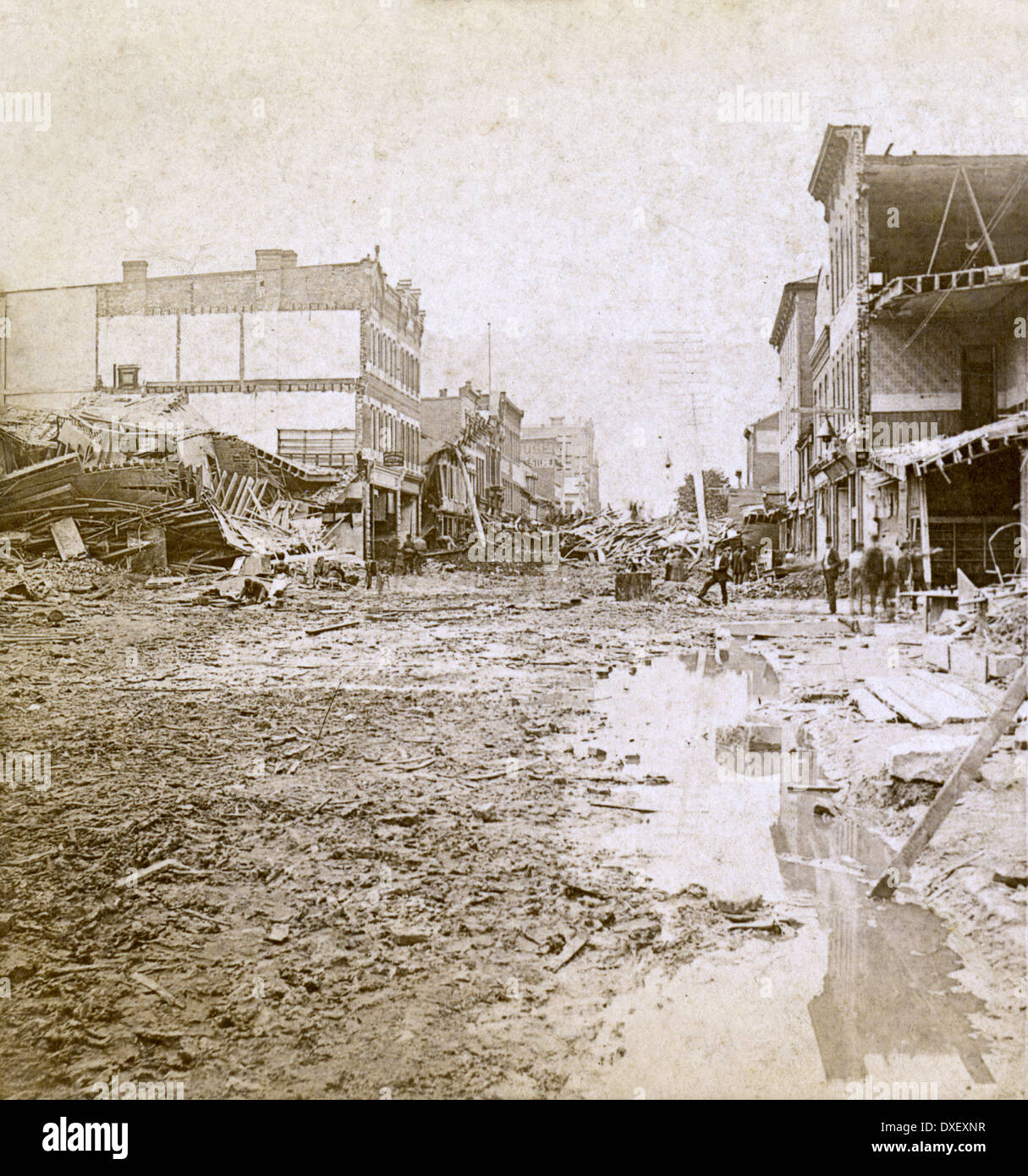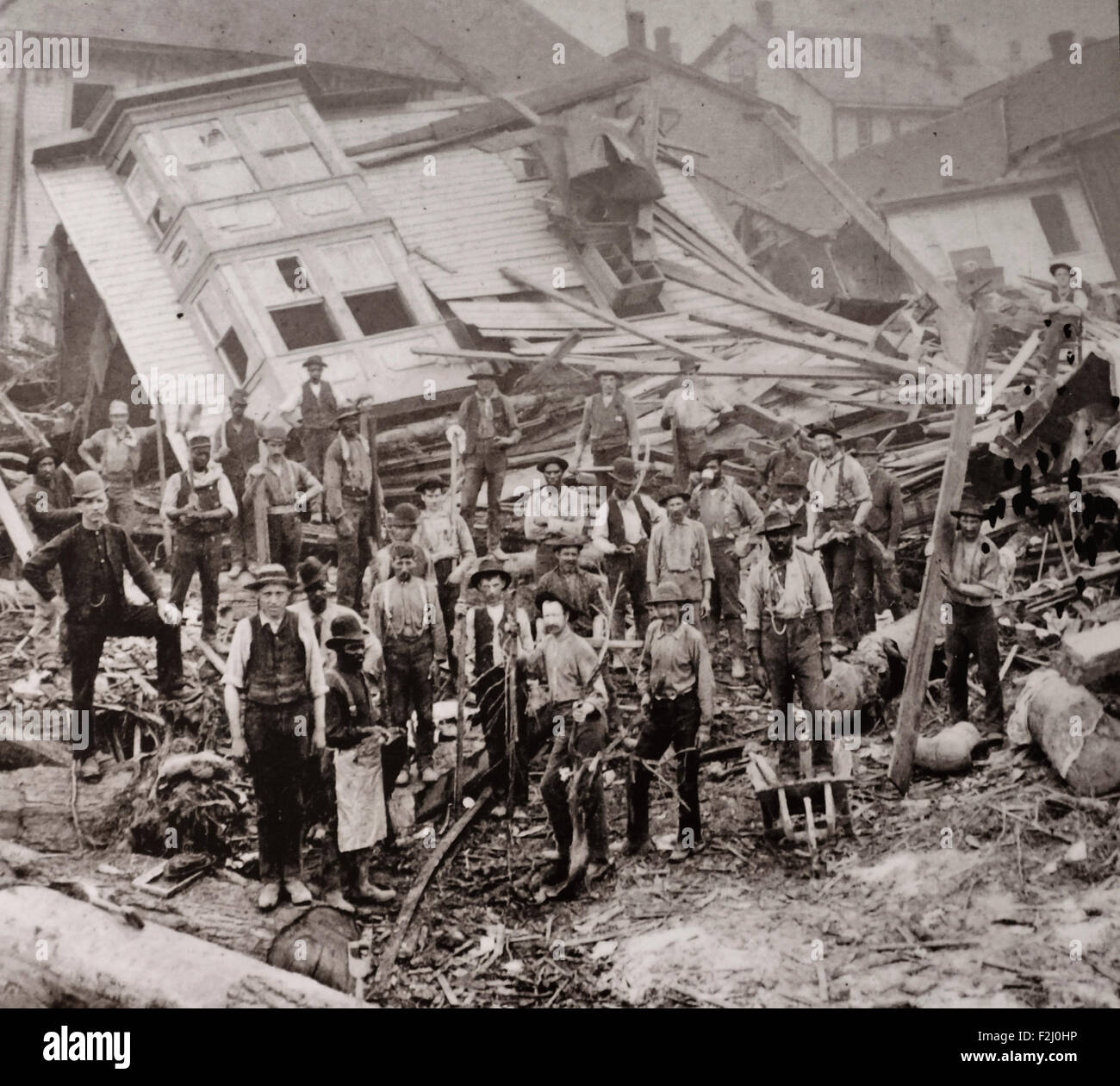
The Deluge of Damnation: Johnstown’s 1889 Flood, a Legend Forged in Water and Iron
America’s tapestry of legends is rich and varied, woven from tales of pioneering spirit, mythical figures, and the raw, untamed power of a burgeoning nation. But not all legends are spun from folklore; some are carved from the bedrock of history, seared into the national consciousness by events so catastrophic they defy easy categorization. These are the legends born of human hubris, natural fury, and the unyielding will to survive. Among the most potent and haunting of these is the Johnstown Flood of May 31, 1889 – a deluge that transformed a thriving industrial city into a watery grave and left an indelible scar on the American psyche, a legend forged in water, iron, and unimaginable loss.
Johnstown, Pennsylvania, in the late 19th century, was a testament to American industrial might. Nestled in a narrow valley at the confluence of the Conemaugh and Stonycreek Rivers, it was a booming steel town, a crucible of innovation and hard work. Its mills, particularly the Cambria Iron Company, churned out steel that built the nation’s railroads and skyscrapers. The city pulsed with life, home to immigrants drawn by the promise of work, families building futures, and a vibrant community spirit. But perched high above Johnstown, approximately 14 miles upstream, lay a silent threat: the South Fork Dam, holding back the vast waters of Lake Conemaugh.
Originally built by the state as part of the Pennsylvania Canal system, the South Fork Dam had a checkered history. Its construction in the 1840s was plagued by engineering challenges, and it was never entirely robust. By the 1880s, the abandoned dam had been purchased by a group of wealthy industrialists from Pittsburgh – a veritable "who’s who" of Gilded Age America, including Andrew Carnegie, Henry Clay Frick, Andrew Mellon, and Robert Pitcairn. They transformed the dam’s reservoir into Lake Conemaugh, the centerpiece of their exclusive South Fork Fishing and Hunting Club. This private retreat, far from the grime and clamor of their industrial empires, offered them a pristine haven for recreation.

However, in their pursuit of leisure, the club members made critical alterations to the dam that would prove catastrophic. To widen the road for their carriages, the spillway – the channel designed to safely carry excess water away from the dam – was narrowed. More critically, the essential discharge pipes, which allowed for the controlled lowering of the lake’s water level for maintenance or in emergencies, were removed and sold for scrap metal. These changes, combined with years of neglect and the use of inferior materials for repairs, rendered the dam a ticking time bomb. Local residents, particularly engineer Daniel J. Morrell, repeatedly voiced concerns about the dam’s integrity, but their warnings were largely dismissed by the powerful club members, who often scoffed at the "cowardly" nature of the Johnstown folk.
The stage was set for tragedy. May 1889 brought an unusual and relentless series of storms to the Appalachian region. Days of torrential rain swelled the rivers and streams, turning the usually placid Lake Conemaugh into a raging inland sea. On May 30th, water levels in the lake were dangerously high. Early on the morning of May 31st, engineers and workers from the South Fork Club desperately tried to reinforce the dam, piling mud and brush against its rapidly eroding face. But the sheer volume and force of the water were too great.
At approximately 3:10 PM on May 31, 1889, the inevitable happened. A section of the South Fork Dam, about 420 feet wide and 72 feet high, gave way with a thunderous roar. The entire lake, some 20 million tons of water (roughly equivalent to the flow of the Mississippi River), was unleashed in a matter of minutes. "It was as if the earth had opened up and swallowed the sky," one terrified witness later recounted.
What followed was an apocalyptic scene. The massive wave, estimated to be 35 to 40 feet high and traveling at speeds of up to 40 miles per hour, roared down the narrow Conemaugh Valley. It was a liquid battering ram, gathering unimaginable momentum and debris as it surged forward. Houses, trees, railroad cars, factories, and entire villages in its path were instantly pulverized and swept away. The sound was said to be a deafening roar, a combination of crashing water, splintering wood, grinding metal, and the terrified screams of people and animals.
When the monstrous wave slammed into Johnstown, it was no longer just water; it was a churning maelstrom of destruction, a colossal, grinding mass of trees, railroad ties, bridges, and the shattered remnants of homes and lives. The city was swallowed whole in less than ten minutes. The force was so immense that it scoured the very foundations of buildings, leaving nothing but bare earth where bustling streets had been moments before.
A chilling and iconic detail of the flood’s impact was the Stone Bridge. This massive, arched railroad bridge, standing 80 feet high and 500 feet long, was designed to withstand the forces of nature. While it largely held, it became a tragic bottleneck. The colossal debris field – an unimaginable tangle of houses, lumber, and human bodies – piled up against its sturdy arches, forming a dam within the city itself. Fuel, escaping from overturned oil cars, ignited the trapped debris, transforming the already horrific scene into a raging inferno. For three days, the Stone Bridge burned, cremating hundreds of trapped victims and casting a pall of smoke and despair over the devastated valley.
The immediate aftermath was a scene of unparalleled desolation. An estimated 2,209 people perished in the Johnstown Flood, making it one of the deadliest natural disasters in U.S. history. Entire families were wiped out; 99 entire families were lost, and 396 children were orphaned. Many bodies were never recovered, swept away by the receding waters or consumed by the Stone Bridge fire. Survivors wandered through the mud-caked ruins, dazed and shell-shocked, searching for loved ones amidst the debris. The air was thick with the stench of death and the acrid smell of smoke.
Yet, from the ashes of devastation, the American spirit of resilience and compassion emerged. News of the disaster, though initially slow to spread due to severed telegraph lines, quickly galvanized the nation. Aid poured in from across the country and even from abroad. Clara Barton, founder of the American Red Cross, arrived in Johnstown within days, leading the organization’s first major peacetime disaster relief effort in the United States. She established hospitals, provided shelter, and organized the distribution of food and supplies. Doctors, nurses, engineers, and volunteers flocked to the scene, offering their skills and their empathy.

The rebuilding of Johnstown began almost immediately, a testament to the tenacious spirit of its people. Despite the overwhelming loss, the community refused to abandon their home. The steel mills were repaired, homes were reconstructed, and life slowly, painstakingly, returned to the valley. But the scars remained, not just on the landscape, but on the collective memory of generations.
The Johnstown Flood is more than just a historical tragedy; it is a legend because it encapsulates profound questions about human responsibility, class disparity, and the limits of power. In the wake of the disaster, a fierce debate erupted over accountability. Legal actions were brought against the South Fork Fishing and Hunting Club. However, due to the prevailing legal doctrines of the era and the immense wealth and influence of the club members, the suits were ultimately unsuccessful. The legal system ruled the disaster an "Act of God," effectively shielding the club and its powerful members from financial liability. This outcome further cemented the flood’s legendary status as a stark illustration of the era’s legal and social inequities, where the lives of the working class were deemed less valuable than the recreational pursuits and financial interests of the elite.
The phrase "Act of God" became a bitter epithet in Johnstown, fueling a lingering sense of injustice that persists to this day. It underscored the perceived invincibility of the wealthy and the vulnerability of ordinary citizens in the face of corporate negligence. This aspect of the flood’s legacy resonates powerfully in American history, serving as a cautionary tale about the dangers of unchecked power and the critical importance of public safety over private privilege.
Even today, the spectral memory of the Johnstown Flood lingers. Locals tell tales of eerie sounds and unexplained phenomena – the ghostly whispers of the lost, the distant roar of the water, the phantom screams of those consumed by the fire at the Stone Bridge. These aren’t just ghost stories; they are manifestations of an unresolved trauma, a community grappling with an event so horrific it defies full comprehension. The flood remains a focal point for historians, engineers, and disaster preparedness experts, who analyze its causes and consequences to prevent similar catastrophes.
The Johnstown Flood of 1889 stands as a somber, yet potent, legend in American history. It is a legend not of mythical beasts or heroic quests, but of a catastrophic intersection of human error, natural fury, and societal imbalance. It reminds us of the fragility of life, the devastating power of water, and the enduring strength of communities to rise from the ashes. It is a legend that compels us to remember the 2,209 souls lost, to question authority, and to forever honor the resilience of a town that refused to be washed away by the deluge of damnation. Johnstown’s story is a permanent testament to the fact that some legends, though born of sorrow, serve as vital lessons, etched forever into the American collective memory, warning us of the consequences when vigilance falters and responsibility is denied.


